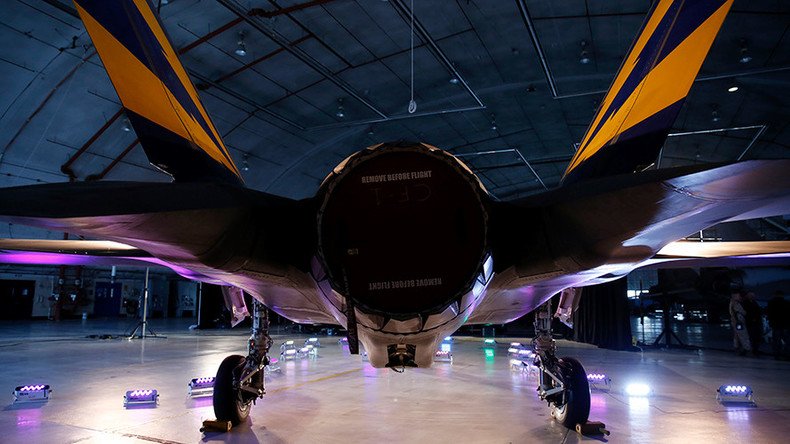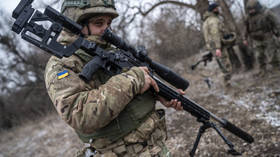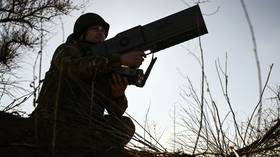Lockheed Martin F-35 Lightning II deploys bombs during tests, nears combat readiness

After years of delay, military pilots finally tested new F-35 warplanes with real bombs, bringing a trillion-dollar Pentagon program centered on the Lockheed Martin stealth jets one step closer to combat readiness.
"This is significant because we're building the confidence of our pilots by actually dropping something off the airplane instead of simulating weapon employment," Lt. Col. George Watkins said in an Air Force release on Tuesday.
'What F-35 will do to ya': Air Force general faints at Pentagon briefing on plane budget https://t.co/IwvulgXV2mpic.twitter.com/y8mbaMB47a
— RT America (@RT_America) February 11, 2016
Airmen of the 388th and 419th Fighter Wing units deployed laser-guided weapons from the Air Force model of the Lockheed Martin F-35 Lightning II at the Hill Air Force Base in Utah last week.
The F-35, as part of the Joint Strike Fighter program, will eventually replace military aircraft currently in use by not just the US, but also Australia, Canada, Italy, the Netherlands, Turkey, and the United Kingdom. In the US, three different models have been developed for the Air Force, Army, and Marines under the Pentagon’s Joint Strike Fighter program.
While the Air Force model has not reached “initial operational capacity,” or IOC, a Marine squadron did so in August 2015. Originally, the Pentagon program predicted IOC would be reached by 2012, but the development of the F-35 has been bumpy.
$400 billion has been spent so far on the F-35, which boasts advanced capabilities in air-to-air combat, air-to-ground strikes, intelligence, surveillance, and reconnaissance. Before the program is through being implemented, it will cost over $1 trillion, becoming the most expensive US weapons system ever.
In addition to being a stealth jet, the F-35 is also equipped with software technology allowing pilots to share and transfer data with commanders and each other and the pilot’s helmet provides a 360-degree perspective. But there have been kinks associated with some of its features.
Heads roll at Lockheed Martin over troubled F-35 program https://t.co/VdguAkyNNppic.twitter.com/HTbqfXjjwQ
— RT (@RT_com) November 2, 2015
Last month, the Pentagon’s Director of Operational Test and Evaluation (DOT&E) issued a report listing “deficiencies” such as breakdowns in the computerized maintenance management system, or CMMS, where it could not tell the difference between new and old parts and which ones needed replacing. Another problem was in the software which “randomly prevented user logins.”
Another issue with the F-35 is its ejection capability. Pilots weighing under 165 pounds are guaranteed a serious neck injury upon ejection, the DOT&E report said, and there is a 25 percent chance of deadly injury. Airmen under 136 pounds are not allowed in an F-35.
Shadow Proof reported that the plane’s Gatling gun, used to provide cover for ground troops, will not have the proper software until 2019, and The Daily Beast reported the Air Force’s version of the gun will only be able to carry 180 rounds, hardly enough for one tactical burst. The F-35 is limited in its capacity for weapons in order to maintain its stealth qualities.
Shooting down US ‘stealth’ jets not that hard, expert warnshttps://t.co/RT5CKlj3uXpic.twitter.com/k25WlPSzbd
— RT America (@RT_America) February 26, 2016
Lockheed Martin, the aircraft’s maker and designer, keeps the manufacture of parts spread across 1,300 suppliers in 45 states to focus political pressure on defending the 133,000 jobs going to building the F-35, Bloomberg reported.
Last summer, the War is Boring blog ran excerpts of a leaked test pilot report which said the F-35 was "at a distinct energy disadvantage" against the currently used F-16, but CNN reported that Lockheed Martin has rejected that reporting as incomplete, noting that the particular F-35 model referenced in that leaked report lacked the software, weapons system, and stealth coating that come with the new F-35s.













